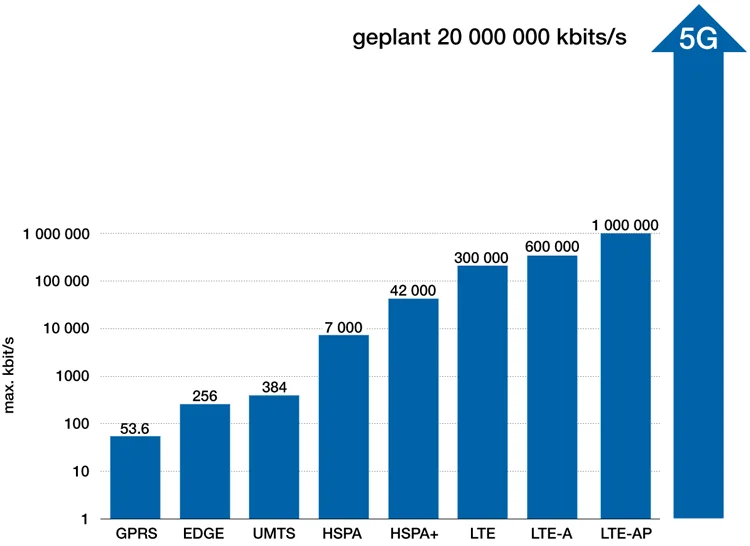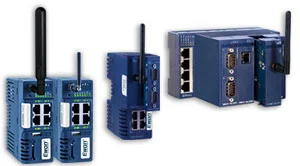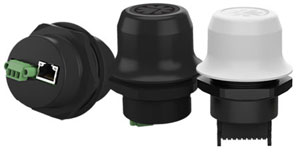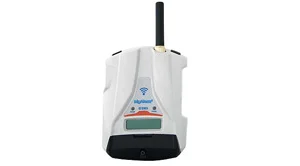Mobile networks have been around since 1958. The first analog networks A, B and C were designed purely for voice communication. The C network was the last to be switched off in 2000.
Since 1998 with the 2G technologies, a major development step in mobile communications has taken place approximately every 10 years. The D and E networks are the first digital networks that also became interesting for industry thanks to the option of data transmission.
Since 2010 with 4G technology and 2020 the 5G era begins. The possible areas of application are being significantly expanded and performance, availability and network quality are being continuously improved.
Physics
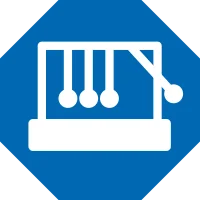
Voice and data are transmitted by modulation via radio waves. Frequency and time multiplexing is used to share the common medium.
The frequency range around 900 megahertz and 1,800 megahertz is used for GSM/GPRS/EDGE.
UMTS uses the frequency range between 1,900 and 2,100 megahertz.
LTE mobile networks use frequencies in the 800 megahertz, 1.8 gigahertz and 2.6 gigahertz ranges. LTE networks in the 700 megahertz range will be added in the future.
5G uses frequencies in the 700 MHz, 1800 MHz, 2100 MHz and 3600 MHz range. The lower the frequency, the greater the range but also the lower the data throughput. High frequencies are more likely to be found in urban areas, low frequencies in rural areas.
The mobile phone infrastructure is provided by various mobile phone providers. The infrastructure consists of radio cells with a receiving and transmitting mast. The size of the cells depends on the required subscriber capacity and can therefore range from a few hundred meters to 5 to 10 km. Together, the cells form a honeycomb-shaped network. A network of cells is called a location area. The transfer of subscribers between the cells is uninterrupted. The handover is decided on the basis of the transmission quality using a threshold value.
Factors influencing reception are attenuation, reflection and shadowing.
Antenna technology is an important topic for mobile radio transmission.
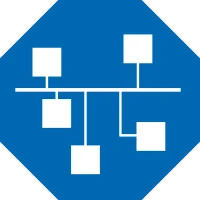
Topology
Global Systems for mobile Communications (GSM) is the second generation of mobile communications technology.
In the first stage, it was only developed for voice transmission.
GPRS (General Packet Radio Service), also known as Generation 2.5 (2.5G), and EDGE (Enhanced Data Rates for GSM-Evolution) are only an extension of the existing GSM standard for data transmission. Data transmission is only activated here when required.
The third generation of mobile communications technology (3G) comprises UMTS
(Universal Mobile Telecommunication System) and the extensions HSPA and HSPA+.
UMTS can work according to two different duplex methods:
- With Frequency Devision Duplex (FDD), the upload and download are divided into different frequency ranges. This enables a data rate of 384 kbit/s.
- In the Time Division Duplex method (TDD), upload and download are transmitted on the same frequencies but at different times (time slots). A data rate of 1920 kBit/s is possible. The TDD method has not been implemented by mobile phone providers in Germany.
The High Speed Packet Access (HSPA) extension uses new techniques for modulation and coding; HSPA is divided into the following standards:
- High Speed Downlink Packet Access (HSDPA) improved download speeds for mobile subscribers such as smartphones, tablets, etc. The use of several simultaneous channels instead of one increases the data rate enormously. A radio cell with HSPA can flexibly distribute up to 15 channels among the subscribers. The number of channels allocated to a subscriber depends on the number of subscribers in a radio cell and its reception quality.
- High Speed Uplink Packet Access (HSUPA) significantly improves the upload speed. A different technology had to be used here than with HSDPA as the transmission power of a subscriber is significantly lower than that of the radio cell. By increasing the coding rate and reducing the size of the channels, the transmission is more susceptible to interference but also significantly faster. The possible data rates are strongly dependent on how close the subscriber is to the base station of the radio cell.
The fourth generation of mobile communications technology is called Long Term Evolution (LTE).
Strictly speaking, the requirements for 4G were only implemented with the LTE-Advanced (LTE-A) extension. But referring to the first version of LTE as 4G has become established and is not a problem in practice. The aim of the new technology was lower energy consumption for battery-powered subscribers, higher range and data rates.
LTE comes with the multiple access method Orthogonal Frequency Division Multiple Access (OFDMA - M) and FDD and TDD techniques already used by UMTS. LTE uses MIMO with support for multiple antennas. An IP-based control and network architecture is used.
Originally, LTE was only designed for data transmission, but with VoLTE (VoIP over LTE), voice communication is now also transmitted digitally as IP telephony. This means that the use of GSM is no longer necessary.
In order to meet the requirements of different devices (e.g. routers, smartphones, tablets, sensors, etc.) that use mobile radio in terms of the required data rates, the devices in the LTE standard have been divided into device categories. This makes it easier to manage the resources of a radio cell. The LTE network is more closely meshed, which is made possible by more compact base stations, as these no longer have to cover GSM and GPRS technology.
The LTE-Advanced expansion increases data transmission rates thanks to improved MIMO technology, carrier aggregation and improvements at the edge of the radio cells (enhanced Inter-cell Interference Coordination - eICIC).
The expectations and requirements for the fifth generation of mobile communications technology (5G) are high;
Data transmission rates of up to 20 Gbit/s with low latency times and a large number of subscribers per radio cell.
Four different frequency ranges are currently used in Germany:
The bands n1 (2100 MHz, formerly 3G), n3 (1800 MHz, formerly 2G, n7 (2600 MHz 4G) and n78 (3600 MHz); the band numbers correspond to those for LTE, 5G use is indicated by the preceding "n" (NewRadio). In the first three frequency ranges, only downloads are currently carried out via 5G; uploads are carried out via 4G. n78 is the top performer in the 5G network; here, the 3.5 GHz network does not consist of paired frequencies (FDD, frequency division duplex) but of a common band for transmitting and receiving. The data rate of 1 Gbit/s can only be achieved by using a broad frequency range.
Improved MIMO is realized via a high number of antenna fields on the radio masts to enable many simultaneous connections; in combination with beam forming, the transmission power can be specifically targeted at subscribers.
5G radio cells are currently available in metropolitan areas and many rural areas.
5G technology in industry makes sense where low latency times are essential or a large number of devices are used in a small area (up to 1 million devices per square kilometer should be possible). High bandwidths are usually not required here.
Private 5G operation models are also possible, for example for mobile machines on company premises that are not to be integrated into public networks. Especially in cases where WLAN technology reaches its limits.
| Mobile radio technology | GSM (2G) | UMTS (3G) | LTE (4G) | 5G | |||||
|---|---|---|---|---|---|---|---|---|---|
| GPRS | EDGE | UMTS | HSPA | HSPA+ | LTE | LTE-A | LTE-AP | ||
| Downlink Data rate in Mbit/s max. | 0,0536 | 0,256 | 0,384 | 7,2 | 42 | 300 150 (DE) | 600 500 (DE) | 1.000 | 20.000 planned (currently approx. 500) |
| Uplink Data rate Mbit/s max. | 0,027 | 0,237 | 0,384 | 5,8 | 11,5 | 75 50 (DE) | 75 50 (DE) | 500 | 10.000 planned (Currently approx. 150) |
| Latency in ms | 500 | 300-400 | 150-170 | 60-70 | 60-70 | 10-40 | 10-40 | 10-40 | 1 planned (currently 10) |
These are theoretically achievable values. In Germany, mobile network providers are currently unable to achieve the full theoretical transmission rates. The possible rates are also dependent on various factors such as reception strength and quality, as well as the network utilization of the radio cell. The hardware status of the mobile modem of the respective subscriber, such as smartphones, tablets, etc., is also decisive.
The Short Message Service (SMS) uses GSM as a basis.
SMS messages can also be used to control devices, for example, and not just for alerts or notifications. A message has a maximum length of 160 characters. Current devices automatically split longer texts into several messages. There is a confirmation of receipt from the network operator, but no confirmation of transmission to the target device. If a target device is temporarily unavailable, the respective text message center stores the message temporarily. SMS Gateways are services offered by mobile phone providers or other providers on the Internet to convert SMS messages into an e-mail or voice message, for example.

In order to be able to use the respective mobile phone technology, a mobile phone contract is required that covers this accordingly.
Most devices still require a SIM card; the so-called eSIM (embedded SIM card) is still not very common in industrial products. When choosing a SIM card, the form factor required by the device should be taken into account (mini-SIM, micro-SIM, nano-SIM). The most common format is micro SIM. There are still some very old SIM cards that require a 5 V power supply, which current devices do not provide, as SIM cards currently work with 1.8 V or 3 V voltage. An APN, user name and password are required when using 3G or newer technologies.
Before setting up the device on site, it makes sense to check the network coverage plans of the providers in the respective country to find out whether mobile phone reception is possible at the desired location and with which technology. There are also inexpensive mobile network analyzers that can be used to carry out on-site measurements of the available providers, technology, reception strength and quality before installation.
LTE-capable mobile radio modems can often also be configured with regard to which technology (2G, 3G or 4G/LTE) should be used. If LTE reception is very poor, it makes more sense to configure the modem to the corresponding standard. The modems usually provide information on signal strength and signal quality.
Areas of application
Ideal for data transmission from mobile machines via the Internet. Mobile radio can also be used to connect remote locations without a wired Internet connection. The independence of local IT systems is another possible application.

Variants / Versions
NarrowBand-IoT (NB-IoT) is based on LTE, uses the 800 to 900 MHz frequency bands and therefore has improved penetration of buildings and area coverage.
Long Term Evolutions for Machines (LTE-M) is a variant of LTE specifically for connecting machines, e.g. for IIoT and mobile networks for their special requirements. Although the data transmission rate is reduced to 1 Mbit/s, the technology is designed for range and battery life.
| LTE-M | NB-IoT | ||||
|---|---|---|---|---|---|
| Data rate | 1,000 kBit/s | 200 kBit/s | |||
| Latency | 15 ms | 10,000 ms | |||
| Range | 15 km | 15 km | |||
LTE-M and NB-IoT are referred to worldwide as the successor technology to 2G technologies (GSM, GPRS, EDGE). Both technologies enable simple and cost-effective radio modules that are ideal for IoT applications.
Remote maintenance
Ewon-Cosy compact router & Ewon Flexy modular remote maintenance and M2M router for remote maintenance and data services


